Are you ready to dive into an amazing world of Brittany colors? I know I sure am!
Sometimes known as Epagneul Bretons, Brittanies are cute hunting dogs that belong to the Spaniel breed.
Despite what many people think, they don’t come from Great Britain. Instead, they owe their name to the Brittany region in Northwestern France, where this dog originates from.
The breed was first recognized by the American Kennel Club (AKC) in 1934 under the name Brittany Spaniel, but the ‘Spaniel’ was dropped in 1982.
This is an energetic dog that is commonly used as a gun dog, but many people love having them as family pets only. Considering their adorable appearances and loveable personalities, this shouldn’t come as a surprise.
Still, one of the physical characteristics they are most easily recognized by is all the amazing coat colors they come in.
Just how many Brittany colors are there, and is there a difference between French Brittanies and standard Brittanies recognized by the AKC?
Let’s find out!
1. Black And White
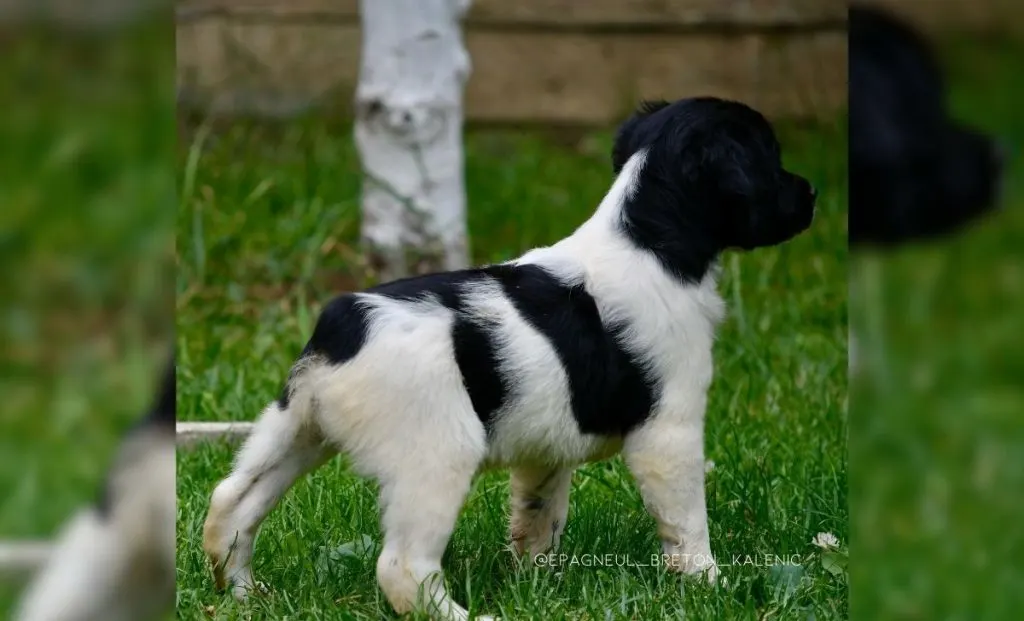
Black and white is a pretty standard color for French Brittanies, but it’s not recognized in the American variety.
In fact, this color is one of the main ways in which you can differentiate a French Brittany from a standard one.
This doesn’t mean that there is anything wrong with this coat color. Different kennel clubs allow different colors, which means that, on some occasions, certain colors will be more common in specific areas.
In other words, while considered a fault by the AKC, the Federation Cynologique Internationale (FCI) and United Kennel Club (UKC) consider this to be a proper Brittany color.
Black markings typically cover the dog’s head, with a few large spots on its back. Smaller spots might be seen on the dog’s chest, lower legs, and on his bobtail. On rare occasions, the black marking can spread from the dog’s back all the way to his rear legs.
This white black dog also sports a black nose, and his eyes are dark brown.
2. Orange And White Clear
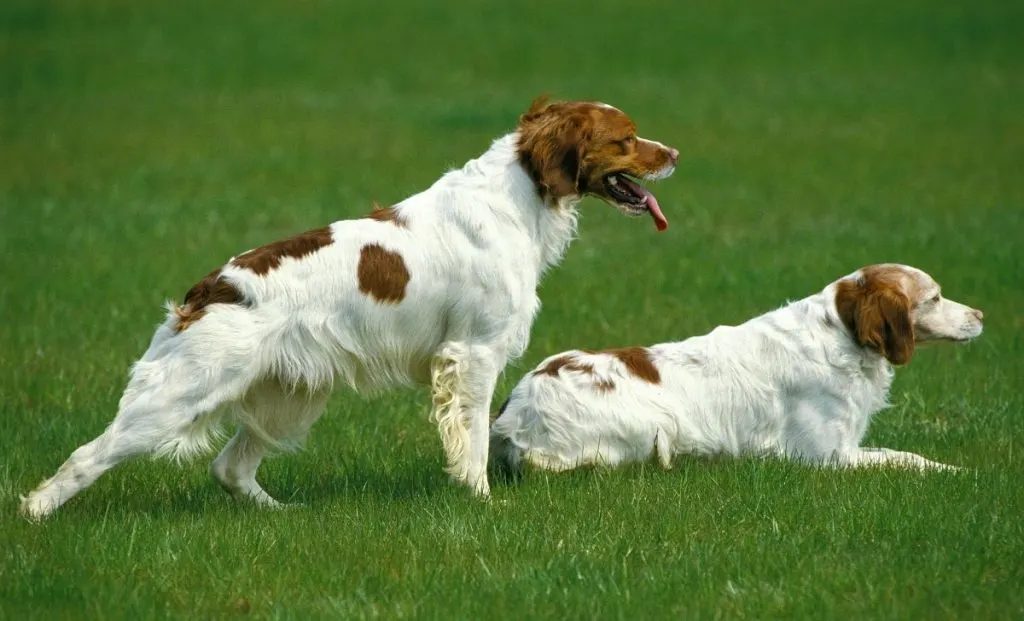
Orange and white is one of the most common Brittany colors, and, according to the Brittany Club of America (BCA), it comes in two combinations: Clear and roan.
Clear orange and white Brittany has a white base color and orange markings on his head, chest, back, and legs. The white is clear, without any ticking.
What’s quite unique is that the dog’s nose should also be orange, and, according to the description from the United Kennel Club, it shouldn’t be darker than the darkest shade on the dog’s coat.
Its brown eyes will more resemble hazel or honey than the deep brown shades seen in white and black pups.
3. Orange And White Roan
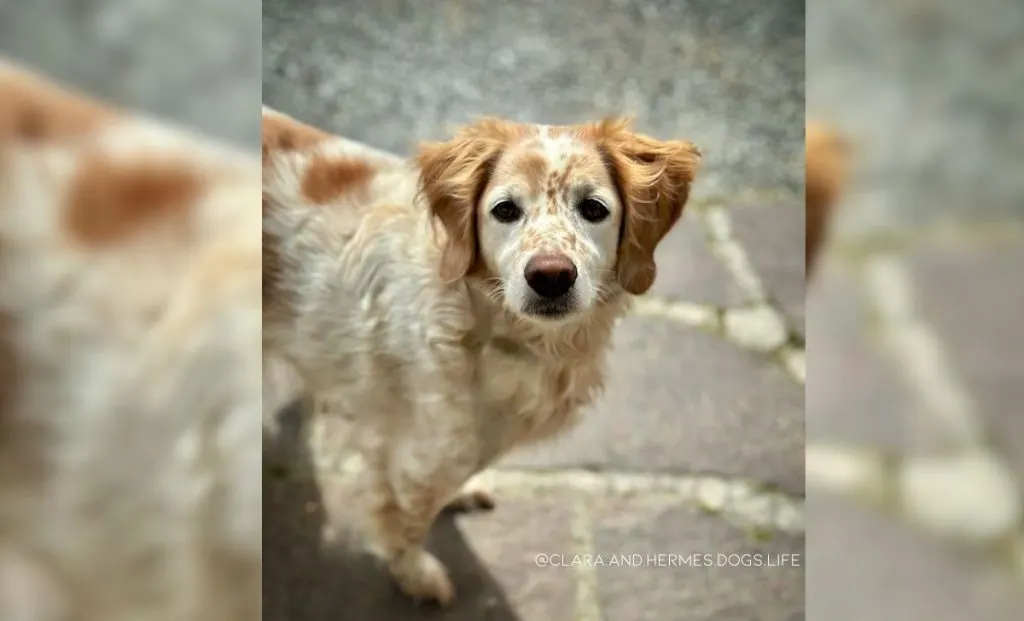
Orange and white roan Brittanies look quite similar to the color combination I’ve just mentioned. The biggest difference is that the white base color is ticked – similar to German Shorthair Pointers.
The ticking is especially prominent on the sides of the muzzle, back, and back legs, although it can be found on the front legs, as well.
This color combination is caused by different genes from the orange and white clear one, although most of the other traits are quite alike. This includes light brown eyes and bright, orange noses.
Some people like to state that ticked Brittanies do better in field trials. There is no proof of this. All Brittanies are intelligent dogs that excel in fieldwork, regardless of color.
4. Black Based Tricolor

Black-based tricolor, also known simply as black tricolor Brittany, is one of the few tricolor variations in which these pups come in.
This dog has a white base coat, but due to a black roan pattern that makes it appear as if the black is bleeding into the white, it seems as if the largest portion of its coat is white.
Next to black and white, these canines also have some tan markings, usually on the sides of muzzle, chest, and paws.
Black tricolor is one of the more common Brittany colors, but it is still very sought after due to its uniqueness.
5. Liver And White Clear
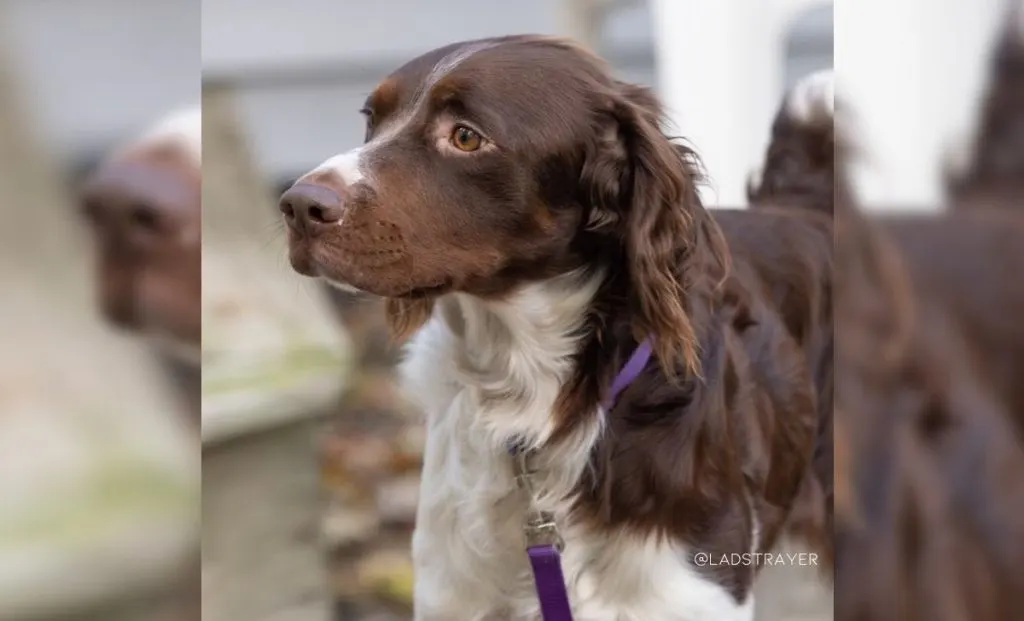
Liver and white is a similar coat color to white and orange, but it’s caused by a liver dilution gene.
This dilution gene affects the black color, turning it into a deep reddish-brown shade. As it affects all pigment and not just hair, this also means that the dog’s nose and eyes will be changed, as well.
While the dog’s nose should be about the same shade as the coat, it’s eyes will be hazel, sometimes even green – although this will usually be considered a fault.
Black and white Brittanies are somewhat rare, which can make you think liver and white ones are, too. However, this isn’t the case.
While not the most common color combination in Brittanies, liver and white is still far from rare – which is a good thing because just look at how cute this pup is!
6. Liver Roan

Another variation of liver dogs, liver roan is quite similar to the white and liver pup. However, instead of having just small spots here or there, it has liver freckling, and it can appear as if the liver markings are spreading to the white basecoat.
Just like other liver varieties, liver roan is accepted in the United States, which means you can take these pups to conformation shows. This may come as a surprise, as in many other breeds, the liver color is considered a fault.
It’s important to note that there are some indications that dilution genes might affect a dog’s health. Most notably, dogs with such genes are prone to color dilution alopecia (CDA), a genetic skin condition that can lead to hair loss and itchy skin but doesn’t affect life expectancy.
Fortunately, CDA seems to be much more prone in blue and Isabella coats, which means you will still have a healthy Brittany even in liver coat color – provided you’ve bought him from a reputable breeder, of course.
7. Liver Based Tricolor
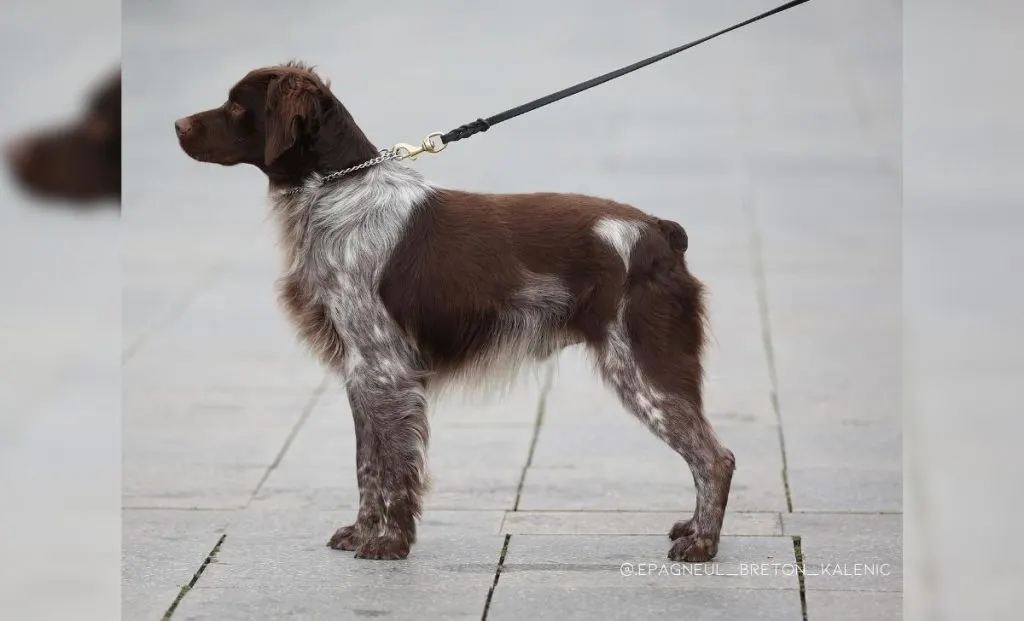
Here is another tricolor combination in these beautiful bird dogs: The liver tricolor.
Liver-based tricolor Brittanies are basically black tricolor dogs, but the black is diluted to the gorgeous liver shade.
As the dilution gene affects only the black color, the tan markings remain untouched. As the contrast between the two hues is lower, the markings might be difficult to spot at first glance.
It’s important to note that, in a way, all tricolor combinations can be considered white tricolors, considering how white is the base coat color.
However, for differentiating purposes, the color of the markings is used to name these pups.
8. Sable
Sable color is quite rare in Spaniel breeds, but it is possible in Brittany.
Many experts consider sable to be a pattern and not a true color, as it is, in fact, caused by two-colored hairs.
Sable Brittanies are, in fact, orange Brittanies, but orange hairs have white tips, which gives them a rather unique appearance.
However, not all major kennel clubs accept sable Brittanies, which means these pups cannot be registered, and almost no reputable breeder will sell them.
This doesn’t necessarily mean that there is something wrong with your sable Brittany. Breeders simply won’t sell dogs that cannot be registered unless occasionally for pet purposes. It’s a good thing this is a versatile breed, so many people keep them as pets.
9. White
White Setters and Spaniels have been considered desirable by owners for years now, and they are very sought after.
Well, I hate to break it to you, but there is no such thing as a healthy white purebred Brittany.
If you see a white Brittany, chances are you are not looking at a purebred dog but at some Brittany mix instead.
Another potential option is albinism. Albinism causes the loss of pigment in dogs, which causes white coats.
Not only that, but it will turn their noses pink and even give their blue eyes a reddish tint.
Unfortunately, albinism is also connected with numerous health issues, including blindness and heart diseases. This is why all kennel clubs and reputable breeders are strictly against breeding dogs with this condition.
Does Coat Color Even Matter?
When buying a dog, some people spend hours, even days, deciding on the color they prefer – especially if there are rumors of certain colors affecting a dog in any way.
For example, some people think that brown dogs are sickly and that black dogs are extremely aggressive.
There is no truth to these rumors. A coat color won’t affect a dog’s temperament in any way, at least not directly.
However, if you see a dog being sold as a purebred that comes in one of those rare coat colors that even the AKC doesn’t recognize, you need to be wary. Most of the time, these dogs are mixed breeds.
Sure, there is nothing wrong with crossbreeds. However, if you’re buying a purebred dog expecting to have some foreknowledge about its health and behavior, you might not get what you expect in such situations.
Also, certain colors – such as white in Brittanies, for example – can be connected with health problems, which might ruin the quality of life for your new pet.
So, as long as you stick to recognized Brittany colors, I can assure you you’ve got nothing to worry about. All Brittanies make wonderful pets and working dogs, and no color will change this.

Vanja’s passion for writing started at an early age, which is why she pursued Journalism as her college degree. She can research any topic and find all the information before you bat an eye, which is a great thing for her job but a terrible one for her husband.
Even as a young child, she fell in love with everything fluffy – but dogs have a special place in her heart due to her childhood companion, a Corgie named Archie.
Motivated by her experiences and driven by a desire to give back to her four-legged companions, she spends her free time volunteering at a local dog shelter.
